Related Research Articles

Albert Einstein was a German-born theoretical physicist who is widely held as one of the most influential scientists. Best known for developing the theory of relativity, Einstein also made important contributions to quantum mechanics. His mass–energy equivalence formula E = mc2, which arises from special relativity, has been called "the world's most famous equation". He received the 1921 Nobel Prize in Physics "for his services to theoretical physics, and especially for his discovery of the law of the photoelectric effect", a pivotal step in the development of quantum theory.

General relativity, also known as the general theory of relativity, and as Einstein's theory of gravity, is the geometric theory of gravitation published by Albert Einstein in 1915 and is the current description of gravitation in modern physics. General relativity generalizes special relativity and refines Newton's law of universal gravitation, providing a unified description of gravity as a geometric property of space and time or four-dimensional spacetime. In particular, the curvature of spacetime is directly related to the energy and momentum of whatever matter and radiation are present. The relation is specified by the Einstein field equations, a system of second order partial differential equations.

A gravitational lens is matter, such as a cluster of galaxies or a point particle, that bends light from a distant source as it travels toward an observer. The amount of gravitational lensing is described by Albert Einstein's general theory of relativity. If light is treated as corpuscles travelling at the speed of light, Newtonian physics also predicts the bending of light, but only half of that predicted by general relativity.

An Einstein ring, also known as an Einstein–Chwolson ring or Chwolson ring, is created when light from a galaxy or star passes by a massive object en route to the Earth. Due to gravitational lensing, the light is diverted, making it seem to come from different places. If source, lens, and observer are all in perfect alignment (syzygy), the light appears as a ring.
In theoretical physics, the Einstein–Cartan theory, also known as the Einstein–Cartan–Sciama–Kibble theory, is a classical theory of gravitation, one of several alternatives to general relativity. The theory was first proposed by Élie Cartan in 1922.

Marcel Grossmann was a Swiss mathematician who was a friend and classmate of Albert Einstein. Grossmann came from an old Swiss family in Zürich. His father managed a textile factory. He became a Professor of Mathematics at the Federal Polytechnic School in Zürich, today the ETH Zurich, specializing in descriptive geometry.
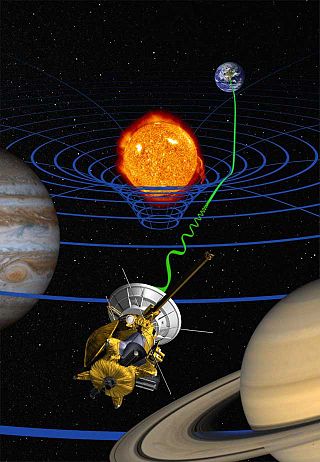
General relativity is a theory of gravitation developed by Albert Einstein between 1907 and 1915. The theory of general relativity says that the observed gravitational effect between masses results from their warping of spacetime.
General relativity is a theory of gravitation that was developed by Albert Einstein between 1907 and 1915, with contributions by many others after 1915. According to general relativity, the observed gravitational attraction between masses results from the warping of space and time by those masses.

Orest Danilovich Khvolson or Chwolson was a Russian and later Soviet physicist and honorary member of the Soviet Academy of Sciences (1920). He is most noted for being one of the first to study the gravitational lens effect.
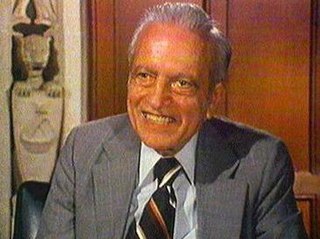
Banesh Hoffmann was a British mathematician and physicist known for his association with Albert Einstein.
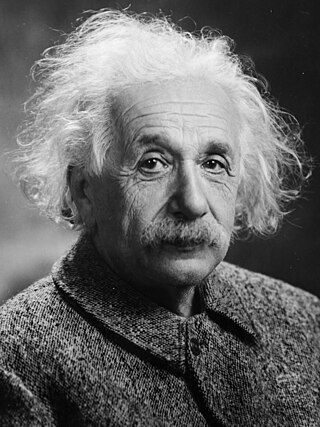
Albert Einstein presented the theories of special relativity and general relativity in publications that either contained no formal references to previous literature, or referred only to a small number of his predecessors for fundamental results on which he based his theories, most notably to the work of Henri Poincaré and Hendrik Lorentz for special relativity, and to the work of David Hilbert, Carl F. Gauss, Bernhard Riemann, and Ernst Mach for general relativity. Subsequently, claims have been put forward about both theories, asserting that they were formulated, either wholly or in part, by others before Einstein. At issue is the extent to which Einstein and various other individuals should be credited for the formulation of these theories, based on priority considerations.

Friedwardt Winterberg is a German-American theoretical physicist and was a research professor at the University of Nevada, Reno. He is known for his research in areas spanning general relativity, Planck scale physics, nuclear fusion, and plasmas. His work in nuclear rocket propulsion earned him the 1979 Hermann Oberth Gold Medal of the Wernher von Braun International Space Flight Foundation and a 1981 citation by the Nevada Legislature. He is also an honorary member of the German Aerospace Society Lilienthal-Oberth.
The Einstein radius is the radius of an Einstein ring, and is a characteristic angle for gravitational lensing in general, as typical distances between images in gravitational lensing are of the order of the Einstein radius.
John Stachel is an American physicist and philosopher of science.

Jürgen Ehlers was a German physicist who contributed to the understanding of Albert Einstein's theory of general relativity. From graduate and postgraduate work in Pascual Jordan's relativity research group at Hamburg University, he held various posts as a lecturer and, later, as a professor before joining the Max Planck Institute for Astrophysics in Munich as a director. In 1995, he became the founding director of the newly created Max Planck Institute for Gravitational Physics in Potsdam, Germany.
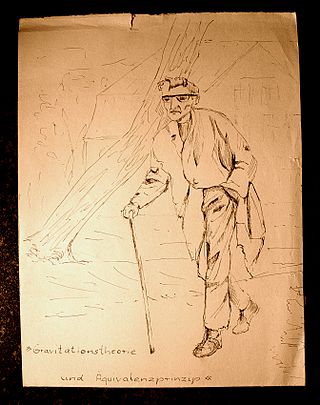
Hans-Jürgen Treder was a German theoretical physicist and in the GDR, specializing in general relativity, astrophysics, and cosmology. He also had an interest in the history of science and philosophy.
Jürgen Renn is a German historian of science, and since 1994 Director at the Max Planck Institute for the History of Science in Berlin.
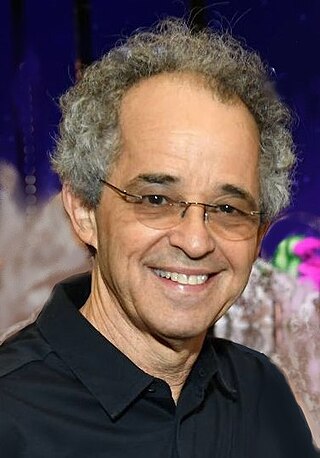
Leo Corry is an Israeli historian of mathematics.

Albert Einstein's discovery of the gravitational field equations of general relativity and David Hilbert's almost simultaneous derivation of the theory using an elegant variational principle, during a period when the two corresponded frequently, has led to numerous historical analyses of their interaction. The analyses came to be called a priority dispute.
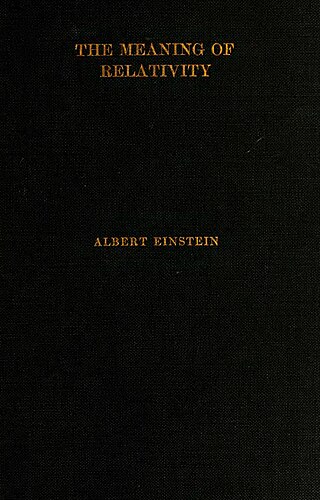
The Meaning of Relativity: Four Lectures Delivered at Princeton University, May 1921 is a book published by Princeton University Press in 1922 that compiled the 1921 Stafford Little Lectures at Princeton University, given by Albert Einstein. The lectures were translated into English by Edwin Plimpton Adams. The lectures and the subsequent book were Einstein's last attempt to provide a comprehensive overview of his theory of relativity and is his only book that provides an accessible overview of the physics and mathematics of general relativity. Einstein explained his goal in the preface of the book's German edition by stating he "wanted to summarize the principal thoughts and mathematical methods of relativity theory" and that his "principal aim was to let the fundamentals in the entire train of thought of the theory emerge clearly". Among other reviews, the lectures were the subject of the 2017 book The Formative Years of Relativity: The History and Meaning of Einstein's Princeton Lectures by Hanoch Gutfreund and Jürgen Renn.
References
- 1 2 3 4 5 "CV Tilman Sauer". Geschichte der Mathematik, Universität Mainz.
- ↑ "Tilman Sauer. List of Publications, Date: February 15, 2021" (PDF). Universität Mainz.
- ↑ Sauer, Tilman (2004). "Albert Einstein's 1916 Review Article on General Relativity". arXiv: physics/0405066 .
- 1 2 Sauer, Tilman (2004). "The challenge of editing Einstein's scientific manuscripts". Documentary Editing. 26: 145–165. arXiv: physics/0412142 . Bibcode:2004physics..12142S.
- ↑ Majer, Ulrich (2010). "The Hilbert Edition: What is it and what is it good for?". Philosophia Scientiae. 14 (1): 141–152. doi:10.4000/philosophiascientiae.138.
- ↑ Brief biography of Sauer, Max Planck Institute for the History of Science
- ↑ "PD Dr. Tilman Sauer". 2012. Archived from the original on 2013-10-02.
- ↑ The importance of the 1912 Zurich notebook was first recognized by John Stachel. Using the 1912 notebook, parts of the GR early history were developed by John D. Norton and published in 1984. Norton, John (1984). "How Einstein found his field equations, 1912-1915" (PDF). Historical Studies in the Physical Sciences. 14 (2): 253–316. doi:10.2307/27757535. JSTOR 27757535. Among other things, Norton found that Einstein had already in 1912 developed ideas on gravitational lensing, which were first published in the 1936 paper Lens-like action of a star by deviation of light in the gravitational field, doi : 10.1126/science.84.2188.506.
- ↑ Renn, Jürgen; Sauer, Tilman; Stachel, John (1997). "The origin of gravitational lensing: A postscript to Einstein's 1936 Science paper". Science. 275 (5297): 184–186. Bibcode:1997Sci...275..184R. doi:10.1126/science.275.5297.184. PMID 8985006. S2CID 43449111.
- ↑ "Eclipses of the stars: Mandl, Einstein, and the early history of gravitational lensing by J. Renn and T. Sauer". Revisiting the Foundations of Relativistic Physics: Festschrift in Honor of John Stachel. Kluwer. 2003. pp. 69–92; Abhay Ashtekar, Robert Cohen, Don Howard, Jürgen Renn, Sahotra Sarkar, Abner Shimony (eds.)
{{cite book}}: CS1 maint: postscript (link) preprint, translated into German in Renn, J.; Sauer, T. (2005). "Im Rampenlicht der Sterne. Einstein, Mandl und die Ursprünge der Gravitationslinsenforschung; Im Rampenlicht dedddddddddr Sterne. Einstein, Mandl und die Ursprünge der Gravitationslinsenforschung". Acta Historica Astronomiae. 27: 210–239. Bibcode:2005AcHA...27..210R. - ↑ Siegfried, Tom (October 1, 2015). "The amateur who helped Einstein see the light". Science News (Sciencenews.org).
- ↑ Sauer, T. (1999). "The Relativity of Discovery: Hilbert's First Note on the Foundations of Physics". Archive for History of Exact Sciences. 53: 529–575. arXiv: physics/9811050 .
- ↑ Sauer, T. (2005). "Einstein equations and Hilbert action: What is missing from page 8 of the evidence for Hilbert's first communication on the foundations of physics?". Archive for History of Exact Sciences. 59: 577–590. doi:10.1007/s00407-005-0100-6.. The first set of page proofs of Hilbert's paper was investigated by Leo Corry, Jürgen Renn, and John Stachel. Corry, L.; Renn, J.; Stachel, J. (1997). "Belated decision in the Hilbert-Einstein priority dispute". Science. 278 (5341): 1270–1273. Bibcode:1997Sci...278.1270C. doi:10.1126/science.278.5341.1270. Daniela Wuensch disputed the opinions of Corry, Renn, and Stachel. Wünsch, Daniela (2005). "New research on the discovery of the field equations of the general relativity by David Hilbert and Albert Einstein" (PDF). Astronomische Nachrichten. 326: 636–637. Bibcode:2005AN....326..636W.
- ↑ Sauer, Tilman (2001). "The Feynman path goes Monte Carlo". In Bachmann, Michael; Janke, Wolfhard; Pelster, Axel; Schmidt, Hans-Jürgen (eds.). Fluctuating paths and fields: festschrift dedicated to Hagen Kleinert on the occasion of his 60th birthday. World Scientific. pp. 29–42. arXiv: physics/0107010 . doi:10.1142/9789812811240_0003. ISBN 978-981-02-4648-8. S2CID 11013017.
- ↑ Sauer, Tilman (2008). "Remarks on the origin of path integration: Einstein and Feynman by Tilman Sauer". In Janke, Wolfhard; Pelster, Axel (eds.). Path Integrals—New Trends and Perspectives: Proceedings of the 9th International Conference, held in Dresden, Germany, September 23 – 28, 2007. World Scientific. pp. 3–13. arXiv: 0801.1654 . doi:10.1142/9789812837271_0001. ISBN 978-981-283-726-4. S2CID 14502716.
- ↑ "Euler-Vorlesung: Archiv".